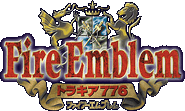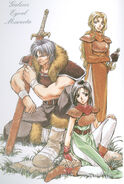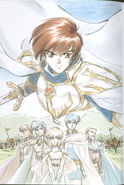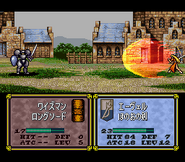Fire Emblem: Thracia 776 (ファイアーエムブレム トラキア776 Faiā Emuburemu: Torakia Nana Nana Roku) is a Japanese tactical role-playing game developed by Intelligent Systems and published by Nintendo, and the fifth installment in the Fire Emblem series. It is also the third and final Fire Emblem series title to be released on the Super Famicom. It was originally released through "Nintendo Power" service on September 1, 1999. The ROM dump of the game was leaked to the Internet on January 21, 2000, during the last days of the Super Famicom. Later, the game was released on the Wii in Japan through the Virtual Console. The graphics are similar to but more detailed than those of Fire Emblem: Genealogy of the Holy War.
Fire Emblem: Thracia 776 is a midquel that takes place between Chapter 5 and Chapter 8 of the previous game, Genealogy of the Holy War, a year before Chapter 6 specifically. The setting and game events occur on the Thracian peninsula in southeastern Jugdral in Gran Calendar Year 776, hence the game's title. This game follows Leif as the main Protagonist. Characters include those from Genealogy of the Holy War, such as Finn, Delmud, and Nanna. Several other characters from Genealogy of the Holy War make cameos, such as Seliph (the main protagonist in part 2 in Genealogy of the Holy War), Julius, Julia, Altena, Corpul, and Hannibal. There are also original characters, such as Halvan, Orsin, Lifis, Shiva, Dagdar, Machyua, and Mareeta.
Characters
See Main article: List of characters in Fire Emblem: Thracia 776
Chapters
See Main article: List of chapters in Fire Emblem: Thracia 776
Units
See Main article: List of Classes in Fire Emblem: Thracia 776
Game Mechanics
Fire Emblem: Thracia 776 is known for its complex gameplay system. It uses the same skill system as in Genealogy of the Holy War. Many of the features introduced have become staples of the series.
Fog of War combat, also known as night combat, a new element present in some chapters. In Fog of War chapters, the map is completely obscured by darkness, causing characters to see only a few tiles around them. Torches and Torch Staves can be used to increase the radius. Torches and Torch Staves lose 1 square radius every turn.
Capturing is a new command available to your units and the enemies. When attempting to capture an enemy, the unit trying to capture has their stats halved. HP must be reduced to 0 to successfully capture. When captured, you can now hold on to the enemy and take anything from their inventory. Releasing captured bosses results in a different death quote. Units without weapons equipped, such as priests, are instantly captured with no combat taking place. If an enemy captures one of your units, they will take all of their items and must be killed to free the unit.
Fatigue is a new system unique to Thracia 776. When a character performs an action, they gain various points of fatigue. When a unit's fatigue exceeds their maximum HP, they cannot participate in the next chapter. This encourages the player to use units sparingly and use more characters. Fatigue can be cured with Stamina Drinks.
Gaiden Chapters were also introduced in Thracia 776. If the player completed specific conditions in certain chapters, they would go to bonus chapters. These chapters are usually filled with valuable items and characters.
Escape chapters were also introduced in Thracia 776 and actually make up a bulk of the first half of the game due to the relatively small army Leif commands at that point. Unlike later Escape chapters, however, which had everyone escaping as soon as the Lord got there, or even chapters which required you to evacuate everyone in order to proceed, the player can leave units behind, leaving them to be captured and possibly rescued in a Gaiden chapter, yet in order to evacuate everyone safely, the player must often have Leif linger, leaving him exposed to danger. Also of note is that unlike later Escape maps, which had limited enemy reinforcements, Escape chapters in Thracia 776 give the enemy unlimited reinforcements with them often occurring on a rigorous schedule, though in some cases, the reinforcements arrive on such a haphazard schedule that it is actually a boon to players looking to give EXP to certain units
Like Fire Emblem: Monshou no Nazo, Thracia 776 also has the Dismount feature, including its similar characteristics, such as that Lance Knights and Axe Knights are forced to use swords when on foot and that cavalry and airborne units are forced to dismount in interior missions.
Thracia 776 also introduced the Rescue command, allowing one character to pick up and carry another (provided they are light enough, and at the temporary expense of some of the carrier's speed and skill). Once Rescued, a character was completely safe, even if the carrier gets into a fight (although if he should die, the rescued character would again be exposed). Mounted characters can not be rescued, but they can rescue those heavier than them. Units with maximum Build can not be rescued. This mechanic helped ease the difficulty a bit, allowing players to save an important character they had unwittingly put in danger, and as such the Rescue command has returned in other games since.
External Links
- Official site of Fire Emblem: Thracia 776 - In Japanese




